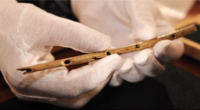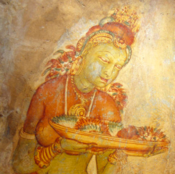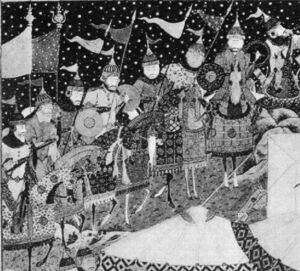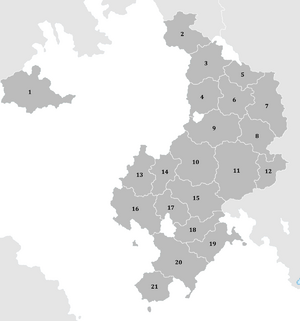Qal'eh
This article is incomplete because it is pending further input from participants, or it is a work-in-progress by one author. Please comment on this article's talk page to share your input, comments and questions. Note: To contribute to this article, you may need to seek help from the author(s) of this page. |
The Sublime State of Qal'eh دولتی الییه قلعه Dolate Eliyye Qal'eh | |
|---|---|
| Motto: بهتر است که امروز به عنوان یک مرد آزاد به عنوان یک برده فرد بمیریم (Persian) Bhetr Aset Keh Amerwez bh 'Enewan ak Merd Azad bh 'Enewan ak Berdh Ferd Bemaram ("Better to die today a free man than tomorrow a slave.") | |
| Anthem: سرود قلیلی ("Qalehi Hymn") | |
 | |
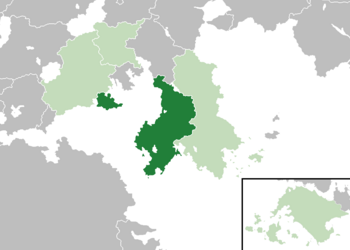 Location of Qal'eh (green) in Western Catai. | |
| Capital | Dahrzor |
| Largest city | Kyderabad |
| Official languages | Qalehi |
| Ethnic groups | 74.2% Qalehis 18.8% Arians 2.2% Uruqs 1.9% Omurans 2.9% Other |
| Religion | State religion: Irsad (Malufi) Recognised minorities: Irsad (Rafada, Muadhi) |
| Demonym(s) | Qalehi |
| Government | Absolute monarchy |
| Ahmad Rouhani | |
| Assembly of Qalehis | |
| Irsadic Assembly of the Peoples of Qal'eh | |
| Establishment | |
• Ardashirvan Empire | c. 476 BC |
• Haydarid Caliphate | c. 606 |
• Khutsog Khanate | c. 902 |
• Assadian Empire | c. 1026 |
• Qalehi Civil War | 1896 - 1901 |
• Monarchy re-established | April 18, 1901 |
• Current constitution | January 21, 1902 |
• 1989 Decree | November 17, 1989 |
| Population | |
• 2013 census | 52,981,727 |
• Density | 39.34/km2 (101.9/sq mi) |
| GDP (nominal) | 2017 estimate |
• Total | $659,728,464,604 |
• Per capita | $12,452 |
| Gini (2015) | high |
| HDI (2015) | very high |
| Currency | Qalehi Zaar (QLZ) |
| Date format | dd-mm-yyyy (official) |
| Driving side | left |
| Calling code | +872 |
| ISO 3166 code | QL |
| Internet TLD | .ql |
The Sublime State of Qal'eh, commonly known as simply Qal'eh (Qalehi: قله Qāleh [kæleh] is a country in Western Catai. With almost 53 million inhabitants, Qal'eh is the 20th most populous country in Aeia. Comprising a land area of Xkm², Qal'eh is one of the largest nations in its region. It borders Kodesh to the east and Uwhistan to the north.
Qal'eh was first conquered by the expansive Ardashirvan Empire in 476 BC, who destroyed many ancient relics of the tribes of Qal'eh following their conquest, while simultaneously assimilating the culture of the tribesman into a more widely-accepted culture throughout the Empire. Many modern Qalehi traditions can have their roots traced back to the Ardashirvan Empire and the culture of the nation is heavily influenced by the conquest. The region broke away from the Ardashirvan Empire as many small successor states after a mutiny in the 4th century BC caused the army and many minorities within the empire to revolt, eventually leading to its demise. Qal'eh would be plunged into nearly a thousand years of various successor states and small kingdoms until it was conquered by the Haydarid Caliphate around 606 CE. The caliphate introduced Irsad from Hisaristan to Qal'eh. The Caliphate was invaded by Turkic/Mongolic tribes in the 10th century CE, and in 902 the Khutsog Khanate was proclaimed. The Khanate dissolved due to internal instability a hundred years later, and fractured into many successor states. The largest successor state, Assadia, led by Muridin Emir Imrah I, reconquered the shattered realm between 1024 and 1026 in a series of conflicts now known as Imrah's Conquests. Modern-day Qal'eh unified around 200 years after the Assadian Caliphate ceased to exist in 1617, when the three powers in the region agreed to unite into a singular nation under Shahanshah Amin Rouhani, the first of to bear the title in the region for almost a thousand years. Qal'eh would undergo a civil war between monarchists loyal to the Shah and Qalehi republicans, which would end in 1902 and lead to the ratification of the 1902 Constitution, which still holds supreme law in the region. It is a controversial topic in Qal'eh, and its lawfulness is debated due to its age.
The sovereign state of Qal'eh is a minor-to-middle regional power in Catai, and enjoys good relations with its neighbour, Kodesh, mainly due to the fact that both nations follow the Malufi sect of Irsad.
Qal'eh enjoys rich cultural history, with many historic relics of tribes, the Ardashirvan Empire and the Assadian Caliphate adorning the country's museums and displays. The "Qalehi Renaissance" introduced exquisite art to the region, taking on board the techniques of many influential Asuran painters and sculptors.
Etymology
Qal'eh comes from Ardashirvani for "the Summit", supposedly named when one of its Shahs viewed the Iranic Sea from Mt. Asfak.
History
Prehistory
Tribes have walked the lands that are now Qal'eh since around 1500 BC, with evidence of several tools and fossils dating back to that era. Most notably, the Flute of Akhir, which was unearthed in 1997 and named after the town it was found in, has provided some insight into the culture and traditions of early Qalehi tribes.
Ardashirvan Empire
Many scattered nations occupied the land for that time period, but first major conquest came in 476 BC when the Ardashirvan Empire conquered Qal'eh in multiple wars between 481 and 476 BC. Qalehi society gradually became more similar to that of the empire, and for around 400 years, the region was stable. There were some small revolts following the conquest, but none of which posed any threat to the expansive empire. It was around the 4th century BC when major revolts across the empire erupted following a mutiny in the Ardashirvan Empire after the Shah refused to pay their wages, due to an ongoing economic crisis throughout the empire. The crisis, along with the revolts and the mutiny the empire lost control of the region and it was split into several successor states.
Haydarid Caliphate
The Haydarid Caliphate began to pose a major threat to the Qalehi states throughout the 6th century CE, during which time it had conquered most of modern-day Hisaristan and Fahran. The Caliphate invaded in the year 603, claiming all lands it invaded for the Irsad faith and converting many traditional Mazdayasna followers from the times of the Ardashirvan Empire. The conquest was brutal and quick, with the various states not being able to coordinate an organised line of defense against the Caliphate. Many internal conflicts between the states had also left their armies shattered and unable to fight properly. This fact, coupled with Haydarid battle experience from its previous conflicts, ultimately led to the entire Qalehi region being subjugated by late 606. The Haydarid Caliphate began to convert most of the region to Irsad, and the Caliphate is credited with introducing widespread Irsad to Qal'eh from Hisaristan, removing many of the traditional Mazdayasna followers and either banishing or executing followers who refused to convert.
Khutsog Khanate
At the very beginning of the 10th century CE, much of Catai was subject to invasion from Turkic and Mongol tribes from the East, and Qal'eh was not an exception to this. Haydarid power over the region had been waning for a few decades by this point, and in 902 CE the Turkic/Mongol tribes invaded the Caliphate from the east. With the Haydarids not being able to put up much resistance, the war was swift, and later on in the same year the Khutsog Khanate was proclaimed, which covered most of modern day Qal'eh. The Khanate suffered from drastic internal stability problems due to the overwhelming majority Qalehi population, who had different traditions to the Turkic tribes from the east. Many Khutsog leaders were assassinated by Qalehi natives while patrolling cities. The Khanate eventually dissolved and fractured into several more successor states in 1017, and the last of the Turkic tribes were pushed out of the region by 1019.
Assadian Caliphate
One of the successor states, Assadia, controlled most of the lucrative southern coast, and used its large income to not only fund its own army, but also to purchase multiple mercenary armies. Starting in 1024, Emir Imrah I began reconquering most of Qal'eh and uniting it under one banner once again. Due to the devastation the revolts and internal fighting with the Ardashirvan Empire, the states did not put up much resistance, and by 1026 Imrah had conquered all the way back to northern Qal'eh. With such an expansive realm, Imrah proclaimed himself Caliph of Assadia and declared the Assadian Caliphate in late 1026, the Caliphate would go on to have many successful and strong Caliphs after the death of Imrah. The Assadian Caliphate is credited with officially introducing Irsad into the Qalehi realm, with it becoming the official state religion in 1029. The Assadian Caliphate would last some 600 years until, like its predecessor, it suffered major internal revolts and eventually collapsed in 1617. Three states emerged from the revolts, but they would go on to form modern-day Qal'eh in an agreement reached in 1802.
Civil War
A civil war gripped Qal'eh between 1896 and 1901 when republican militias seized much of northern Qal'eh and proclaimed the Irsadic Republic of Arianshahr, the civil war was bloody with hefty losses on both sides, but the monarchist Qal'eh eventually emerged victorious when their forces stormed Dahrzor on April 18, 1901. The day is now celebrated as Liberation Day throughout Qal'eh. Shahanshah Muhammad Nazeri ratified the current constitution of Qal'eh on April 15, 1902.
Modern Era
The two major ethnic groups within the nation, Qalehis and Arians, have a tense relationship which has been ongoing for some 30 years (since 1989), when Shahanshah Ahmad Rouhani passed a decree giving native Qalehis priority over Arians over things such as jobs, healthcare and applying for places in the government and military. Several Arian revolts have happened across the 30 year span but so far all have been successfully put down by the Qalehi military.
Geography
Climate
The climate of Qal'eh consists of extremely hot and arid summers in the north and central regions, with little to no rain falling in the regions for most of the year. The southern coast of Qal'eh enjoys cooler summers and winters and more rainfall than its northern and central counterparts, with much of the region being covered in temperate forests, especially on the coasts of the Iranic Sea and Majulan Ocean.
Administrative Divisions
Qal'eh is divided into 21 provinces, each with its own governor personally appointed by the Shahanshah. Most of the more populous provinces, including the capital Dahrzor and largest city Kyderabad, are located in the south of the country.
Qal'eh has a high urban growth rate, with the urban population increasing from 55% to 62% between 2000 and 2017. It is predicted that by 2030, Qalehi urban population will succeed 75%. The country's largest city, Kyderabad, attracts around 150,000 migrants per year, and is an economic and cultural hub of Western Catai.
| Number on map | Province Name | Population | Number on Map | Province Name | Population |
|---|---|---|---|---|---|
| 1 | Kasahgan | 3,762,839 | 12 | Tudasht | 493,277 |
| 2 | Saremeh | 1,873,192 | 13 | Shemrabad | 2,026,883 |
| 3 | Malakeh | 1,916,283 | 14 | Mamdeh | 1,739,288 |
| 4 | Qol-e | 1,581,283 | 15 | Gonbaz | 2,028,772 |
| 5 | Ghazab | 209,812 | 16 | Dahrzor | 6,434,719 |
| 6 | Kashkamir | 972,277 | 17 | Behesht | 2,023,889 |
| 7 | Yadabad | 1,482,662 | 18 | Qujd | 2,273,992 |
| 8 | Pawari | 892,039 | 19 | Kodyan | 3,019,837 |
| 9 | Chah Maku | 2,972,377 | 20 | Kyderabad | 8,980,273 |
| 10 | Tajabad | 3,663,820 | 21 | Zarghari | 2,273,930 |
| 11 | Gur Nasab | 2,360,283 |
Government and Politics
Qal'eh is an absolute monarchy, and has been since its foundation in 1802. Between 1802 and 1902, the Shahanshah had unlimited power throughout the Qalehi realm. However, after the 1902 constitution was ratified after the Qalehi Civil War, the Shahanshah's powers were somewhat limited.
Shahanshah
The Shahanshah is responsible for supervising (and in some cases, enacting) laws and policies throughout Qal'eh. The Shahanshah holds near-absolute power over the region as outlined in the 1902 Constitution. The Shahanshah also attends major foreign relations events as the representative of Qal'eh, but can assign diplomats in his stead, which is usually the case for smaller foreign visits. The Shahanshah acts as the official head-of-state of Qal'eh and is the Commander of the Qalehi Armed Forces.
Legislature
The legislature of Qal'eh, known as the Irsadic Assembly of the People's of Qal'eh or just the Irsadic Assembly, is a unicameral body consisting of 178 members, who are responsible for drafting laws, debating policies, ratifying treaties and some economic aspects of the country, including the annual budget. The Irsadic Assembly is also responsible for drafting amendments to the constitution. All laws that exit the Irsadic Assembly must be ratified by the Shahanshah. All candidates for the Irsadic Assembly require approval from the Assembly of Qalehis.

The Assembly of Qalehis consists of 10 field-specific experts, all appointed by the Shahanshah. The Assembly of Qalehis is responsible for interpreting the Constitution, and scrutinising laws passed by the Irsadic Assembly. If a law is deemed incompatible with the Consitution or the Iqar (Irsadic law), it is sent back to the Irsadic Assembly for revision. The Assembly of Qalehis is also responsible for supervising passed amendments to the 1902 Constitution, the last of which was in 1998. The Assembly of Qalehis may ignore amendments that failed to receive majority vote in the Irsadic Assembly, and must implement amendments that received over 95% of votes. The Assembly of Qalehis ultimately have the final decision if the amendment carried a majority of less than 95%.
Law
The Assembly of Qalehis appoint the Judiciary under the supervision of the Shahanshah. Court rulings can be appealed to the Assembly of Qalehis, although the legitimacy and impartiality of this appeal process is debated. Qalehi law comprises Iqar Law and other laws specific to the region. The Shahanshah may enact Royal Decrees with the consent of the Assembly of Qalehis, which have the full force of law. One notorious example is the 1989 Decree, which causes political turmoil in Qal'eh to this day.
Foreign Relations
Qalehi relations with most of Western Catai are stable, and the nation enjoys good relations with its neighbour, Kodesh, both of whom are Malufi absolute monarchies.
Military
Qal'eh has three branches that make up its military forces, the Army, Navy and Air Force. The Qalehi Armed Forces are made up 257,500 active troops, 71,000 of which are conscripts, and 391,000 reserve troops, totalling just under 650,000 trained troops.
Qal'eh spends just under $12 billion on its military, totalling 1.8% of its GDP or $225 per capita.


